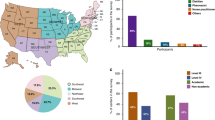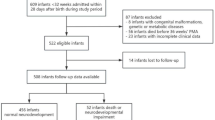Abstract
Background
This research will explore non-linear relationship between vitamin D status on admission and bronchopulmonary dysplasia (BPD) in preterm infants.
Methods
Data were retrospectively collected on preterm infants ≤32 weeks gestation and ≥28 weeks gestation hospitalized in our hospital between Jan. 2019 and Jul. 2022, which were classified into BPD and non-BPD groups according to BPD diagnostic criteria. Independent influences between the two groups were staged using comparison of differences between groups, univariate analysis, multivariate analysis, smoothed curve fitting, and threshold effect staging.
Results
255 preterm infants were enrolled in this research, including 135 males and 120 females, with a mean gestational age of 30.59 ± 0.86 weeks. Vitamin D status on admission was an independent protective factor for BPD in preterm infants, with a 6% reduction in the probability of BPD for every 1 ng/ml increase in vitamin D status on admission (p = 0.036). There was also a non-linear relationship, with each 1 ng/ml increase in vitamin D status on admission being associated with an 87% reduction in the incidence of BPD when vitamin D status was <12.82 ng/ml (p = 0.010).
Conclusion
Vitamin D status on admission and BPD are non-linearly in preterm infants at 28–32 weeks gestation.
Impact statement
-
Analyzing the relationship between vitamin D status on admission and BPD.
-
A nonlinear relationship and turning point between vitamin D status on admission and BPD was derived by curve fitting and threshold effect.
-
We provide a new reference point for vitamin D supplementation for the prevention of neonatal BPD and to avoid ineffective overmedication.
This is a preview of subscription content, access via your institution
Access options
Subscribe to this journal
Receive 14 print issues and online access
$259.00 per year
only $18.50 per issue
Buy this article
- Purchase on SpringerLink
- Instant access to full article PDF
Prices may be subject to local taxes which are calculated during checkout


Similar content being viewed by others
Data availability
The datasets generated during and/or analyzed during the current study are not publicly available due to human research ethics requirements but are available from the corresponding author on reasonable request.
References
Northway, W. H. Jr, Rosan, R. C. & Porter, D. Y. Pulmonary disease following respirator therapy of hyaline-membrane disease. Bronchopulmonary dysplasia. N. Engl. J. Med. 276, 357–368 (1967).
Jobe, A. H. & Bancalari, E. Bronchopulmonary dysplasia. Am. J. Respir. Crit. Care Med. 163, 1723–1729 (2001).
Stoll, B. J. et al. Neonatal outcomes of extremely preterm infants from the NICHD Neonatal Research Network. Pediatrics 126, 443–456 (2010).
Stoll, B. J. et al. Trends in care practices, morbidity, and mortality of extremely preterm neonates, 1993-2012. JAMA 314, 1039–1051 (2015).
Horbar, J. D. et al. Variation in performance of neonatal intensive care units in the United States. JAMA Pediatr. 171, e164396 (2017).
Li, P. P. & Zhao, W. Definition evolution and epidemiological characteristics of bronchopulmonary dysplasia in premature infants. Chin. J. Neonatol. 35, 385–388 (2020).
Jensen, E. A. et al. Severity of bronchopulmonary dysplasia among very preterm infants in the United States. Pediatrics 148, e2020030007 (2021).
Davidson, L. M. & Berkelhamer, S. K. Bronchopulmonary dysplasia: chronic lung disease of infancy and long-term pulmonary outcomes. J. Clin. Med. 6, 4 (2017).
Bhandari, A. & Panitch, H. B. Pulmonary outcomes in bronchopulmonary dysplasia. Semin. Perinatol. 30, 219–226 (2006).
Hartling, L., Liang, Y. & Lacaze-Masmonteil, T. Chorioamnionitis as a risk factor for bronchopulmonary dysplasia: a systematic review and meta-analysis. Arch. Dis. Child Fetal Neonatal Ed. 97, F8–F17 (2012).
Bose, C. et al. Fetal growth restriction and chronic lung disease among infants born before the 28th week of gestation. Pediatrics 124, e450–e458 (2009).
Leary, S., Das, P., Ponnalagu, D., Singh, H. & Bhandari, V. Genetic strain and sex differences in a hyperoxia-induced mouse model of varying severity of bronchopulmonary dysplasia. Am. J. Pathol. 189, 999–1014 (2019).
Antonucci, R., Contu, P., Porcella, A., Atzeni, C. & Chiappe, S. Intrauterine smoke exposure: a new risk factor for bronchopulmonary dysplasia? J. Perinat. Med. 32, 272–277 (2004).
Ahmad, S. et al. Vitamin D and its therapeutic relevance in pulmonary diseases. J. Nutr. Biochem. 90, 108571 (2021).
Brehm, J. M. et al. Vitamin D insufficiency and severe asthma exacerbations in Puerto Rican children. Am. J. Respir. Crit. Care Med. 186, 140–146 (2012).
Mao, X. et al. Vitamin D and IL-10 deficiency in preterm neonates with bronchopulmonary dysplasia. Front. Pediatr. 6, 246 (2018).
Ge, H. et al. The association of vitamin D and vitamin E levels at birth with bronchopulmonary dysplasia in preterm infants. Pediatr. Pulmonol. 56, 2108–2113 (2021).
Joung, K. E. et al. Vitamin D and bronchopulmonary dysplasia in preterm infants. J. Perinatol. 36, 878–882 (2016).
Tsuprykov, O. et al. Opposite correlation of 25-hydroxy-vitamin D- and 1,25-dihydroxy-vitamin D-metabolites with gestational age, bone- and lipid-biomarkers in pregnant women. Sci. Rep. 11, 1923 (2021).
Çetinkaya, M. et al. Maternal/neonatal vitamin D deficiency: a risk factor for bronchopulmonary dysplasia in preterms? J. Perinatol. 35, 813–817 (2015).
Ali, Z., Schmidt, P., Dodd, J. & Jeppesen, D. L. Predictors of bronchopulmonary dysplasia and pulmonary hypertension in newborn children. Dan. Med. J. 60, A4688 (2013).
Yin, J. et al. Mechanical ventilation characteristics and their prediction performance for the risk of moderate and severe bronchopulmonary dysplasia in infants with gestational age <30 weeks and birth weight <1500 g. Front. Pediatr. 10, 993167 (2022).
Park, H. W. et al. Association between vitamin D level and bronchopulmonary dysplasia: a systematic review and meta-analysis. PLoS ONE 15, e0235332 (2020).
Kalikkot Thekkeveedu, R., Guaman, M. C. & Shivanna, B. Bronchopulmonary dysplasia: a review of pathogenesis and pathophysiology. Respir. Med. 132, 170–177 (2017).
Sakurai, R. et al. 1alpha,25(OH)2D3 and its 3-epimer promote rat lung alveolar epithelial-mesenchymal interactions and inhibit lipofibroblast apoptosis. Am. J. Physiol. Lung Cell Mol. Physiol. 297, L496–L505 (2009).
Hu, J. et al. Vitamin D ameliorates apoptosis and inflammation by targeting the mitochondrial and MEK1/2-ERK1/2 pathways in hyperoxia-induced bronchopulmonary dysplasia. J. Inflamm. Res. 15, 4891–4906 (2022).
Mandell, E. et al. Antenatal endotoxin disrupts lung vitamin D receptor and 25-hydroxyvitamin D 1α-hydroxylase expression in the developing rat. Am. J. Physiol. Lung Cell Mol. Physiol. 309, L1018–L1026 (2015).
Weisman, Y. Maternal, fetal and neonatal vitamin D and calcium metabolism during pregnancy and lactation. Endocr. Dev. 6, 34–49 (2003).
McCarthy, R. A. et al. Vitamin D nutritional status in preterm infants and response to supplementation. Br. J. Nutr. 110, 156–163 (2013).
Burris, H. H. et al. Vitamin D status among preterm and full-term infants at birth. Pediatr. Res. 75, 75–80 (2014).
Misra, M., Pacaud, D., Petryk, A., Collett-Solberg, P. F. & Kappy, M. Drug and Therapeutics Committee of the Lawson Wilkins Pediatric Endocrine Society. Vitamin D deficiency in children and its management: review of current knowledge and recommendations. Pediatrics 122, 398–417 (2008).
Hollis, B. W., Johnson, D., Hulsey, T. C., Ebeling, M. & Wagner, C. L. Vitamin D supplementation during pregnancy: double-blind, randomized clinical trial of safety and effectiveness. J. Bone Min. Res. 26, 2341–2357 (2011).
Wagner, C. L. et al. A randomized trial of vitamin D supplementation in 2 community health center networks in South Carolina. Am. J. Obstet. Gynecol. 208, 137.e1–13 (2013).
Acknowledgements
The authors thank the research personnel and the research volunteers involved with the project.
Funding
This work was supported by the National Natural Science Foundation of China (81801510, 82071693) and supported by Natural Science Foundation of Hunan Province (2019JJ50930, 2021JJ31046).
Author information
Authors and Affiliations
Contributions
Shuo Wang: substantial contributions to conception and design, acquisition of data, or analysis and interpretation of data; drafting the article or revising it critically for important intellectual content; and interpretation of data; final approval of the version to be published. Mingjie Wang: substantial contributions to acquisition of data. Xiaohe Yu: substantial contributions to acquisition of data. Chuanding Cao: substantial contributions to acquisition of data. Ying Ding: substantial contributions to acquisition of data. Mei Lv: substantial contributions to acquisition of data. Yang Liu: substantial contributions to acquisition of data. Meiyan Chu: substantial contributions to acquisition of data. Keren Fang: substantial contributions to acquisition of data. Zhengchang Liao: substantial contributions to conception and design, acquisition of data, or analysis and interpretation of data; drafting the article or revising it critically for important intellectual content; and interpretation of data; final approval of the version to be published. Shaojie Yue: substantial contributions to conception and design, acquisition of data, or analysis and interpretation of data; drafting the article or revising it critically for important intellectual content; and interpretation of data; final approval of the version to be published.
Corresponding authors
Ethics declarations
Competing interests
The authors declare no competing interests.
Additional information
Publisher’s note Springer Nature remains neutral with regard to jurisdictional claims in published maps and institutional affiliations.
Rights and permissions
Springer Nature or its licensor (e.g. a society or other partner) holds exclusive rights to this article under a publishing agreement with the author(s) or other rightsholder(s); author self-archiving of the accepted manuscript version of this article is solely governed by the terms of such publishing agreement and applicable law.
About this article
Cite this article
Wang, S., Wang, M., Yu, X. et al. Nonlinear relationship between vitamin D status on admission and bronchopulmonary dysplasia in preterm infants. Pediatr Res 97, 2074–2081 (2025). https://doi.org/10.1038/s41390-024-03621-6
Received:
Revised:
Accepted:
Published:
Issue date:
DOI: https://doi.org/10.1038/s41390-024-03621-6



